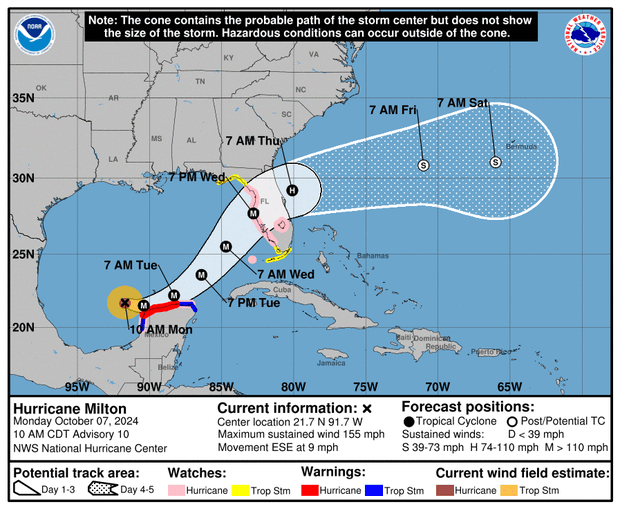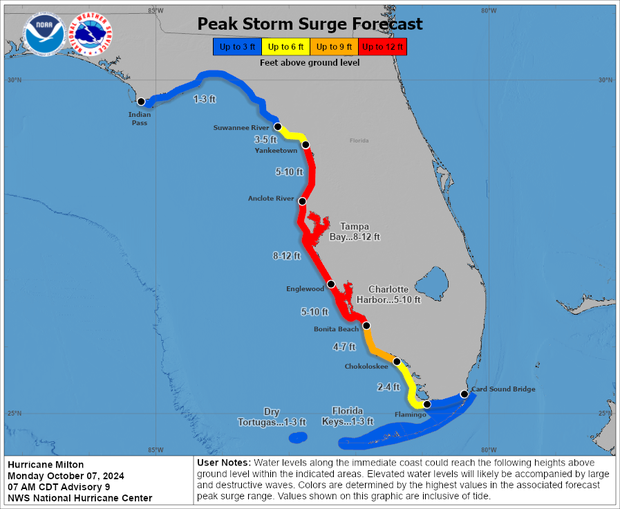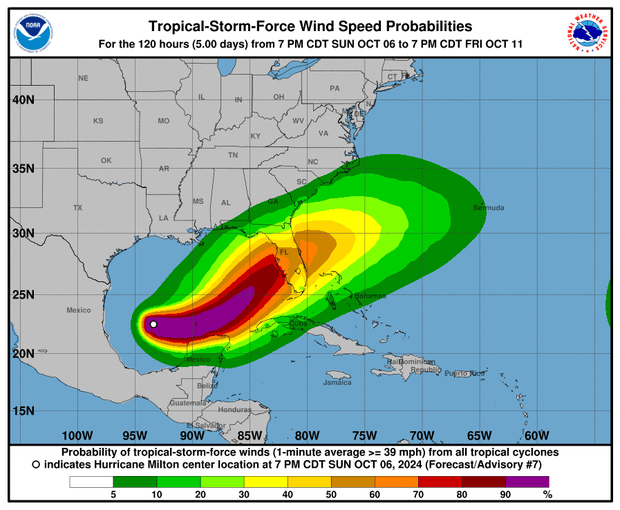Hurricane Milton surges to Category 5, expected to hit Florida as a major hurricane this week
Hurricane Milton has grown into a powerful Category 5 storm, less than two days after it developed in the Gulf of Mexico.
The hurricane was expanding and intensifying quickly Monday while tracking eastward over warm Gulf waters, with the latest growth happening much faster than forecasts suggested.
Milton's winds surged to 160 mph Monday morning, according to the latest update from the hurricane center — exceeding the threshold for Category 5.
Forecasters with the National Hurricane Center predict the storm will strike Florida's western Gulf Coast as a major hurricane in the middle of the week, likely later on Wednesday. It comes after Florida's Gulf Coast was just hit by Hurricane Helene.
Milton is expected to weaken somewhat before making landfall, but projections wavered Monday morning as Milton's rapid evolution continued. At this point, forecasters anticipate the hurricane will have maximum sustained winds of 145 mph around noon Wednesday and 125 mph just before midnight, and landfall is slated to happen at some time in between.
The most likely track suggests Milton could make landfall in or near the Tampa Bay area and remain a hurricane as it moves across central Florida into the Atlantic Ocean, forecasters said.
That path would largely spare other southeastern states ravaged by Helene, which caused catastrophic damage from Florida into the Appalachian Mountains, killing more than 230 people.
While Milton is expected to be a smaller storm than Helene, with a smaller wind field, it appears to be heading for a much more densely populated area, and storm surge could cause major problems in some places, according to CBS News weather senior producer David Parkinson.
A stretch of the Florida Gulf Coast, including Tampa Bay, could see surges up to 12 feet above normal water levels if their timing coincides with high tide.
South Florida communities were already feeling some of the storm's early impacts on Sunday, as Miami-Dade County and the Everglades reported flooding, said CBS News Miami meteorologist KC Sherman. Sherman told residents potentially in the path of the hurricane to expect a flood watch through Thursday.
"Milton is moving slowly but is expected to strengthen rapidly," the hurricane center said earlier Sunday. "There is increasing confidence that a powerful hurricane with life-threatening hazards will be affecting portions of the Florida west coast around the middle of this week."
Milton rapidly intensifies over warm Gulf waters
Milton rapidly intensified as it moved over water with temperatures hovering around 85 degrees Fahrenheit, which Parkinson describes as like "premium octane fuel for any hurricane."
Exceptionally high sea surface temperatures have been made significantly more likely by human-caused climate change, according to analysis by Climate Central.
Parkinson said the latest advisory from the National Hurricane Center suggests a peak at Category 4 and a landfall intensity of Category 3.
"As always, this far out, people need to prepare for one category above, which means preparations should be for a Category 5 maximum, and a strong Category 4 landfall," Parkinson said.
Landfall location is key
Forecast models show Milton headed for Florida's west coast. The direction Milton approaches from is a large concern, Parkinson said. Instead of running parallel to the coast, Milton is coming in at a 90-degree angle.
"That means that storm surge will be piled into the coast," Parkinson said, comparing it to what happened in New Jersey during Hurricane Sandy.
The landfall location will be key, he explained.
"If landfall is south of a given location, storm surge will be minimal, rain will be heavy, and any of the worst wind will be confined to the first 25 miles from the eye," Parkinson said. "If landfall is north of a given location, they'll experience catastrophic and historic storm surge, relatively minimal rain, and wind confined to the first 25 miles from the eye. Storm surge will extend southward of the landfall point for the entire west coast."
Parkinson also explained that landfall to the north of Tampa Bay would be especially devastating for that metro area.
"At least half the model runs to give a St. Pete or north landfall. I cannot think of a worse case scenario than that for Tampa Bay," he said. "If that comes to fruition, it will be the worst natural disaster Tampa has ever seen. If, however, landfall occurs in Sarasota or south, Tampa will dodge the storm surge, but places like Fort Myers will bear the worst inundation."
Florida officials issue warnings
Gov. Ron DeSantis first issued emergency orders Saturday and then expanded the declaration Sunday to include 51 counties. He said Floridians should prepare for more power outages and disruptions, making sure they have a week's worth of food and water and were ready to hit the road.
He said while the precise point of landfall remained unclear, it was clear that Florida would be hit hard, saying he couldn't see "any scenario where we don't have major impacts at this point."
"You have time to prepare," he said urging Floridians "to be sure your hurricane preparedness plan is in place."
"Know your evacuation zone — there will be mandatory and voluntary evacuations," said DeSantis.
The National Weather Service said early Monday morning that a hurricane watch was in effect for the Gulf coast of Florida from Chokoloskee northward to the mouth of the Suwanee River, including Tampa Bay, and the Dry Tortugas. A storm surge watch was issued for the Florida Gulf Coast from Flamingo northward to the Suwannee River, including Charlotte Harbor and Tampa Bay.
The St. Petersburg-Tampa Bay area was still cleaning up extensive damage from Helene and its powerful storm surge. Twelve people perished as Helene swamped the coast, with the worst damage in the state along the narrow, 20-mile string of barrier islands that stretch from St. Petersburg to Clearwater.
All classes and school activities in St. Petersburg's Pinellas County preemptively closed Monday through Wednesday as Milton approached, and Tampa opened city garages for free so people could park their cars safe from the next floodwaters.
The Pinellas County government also issued mandatory evacuation orders for long-term care facilities, assisted living facilities and hospitals in designated evacuation zones due to the threat posed by Hurricane Milton.
"All available state assets... are being marshaled to help remove debris," DeSantis said. "We're going 24-7... it's all hands on deck."
Heavy rain was possible in Mexico's Yucatan Peninsula on Monday, the hurricane center said, with more rain and heavy winds most likely arriving later Tuesday through Wednesday night in Florida. The hurricane center said rainfall totals of up to 15 inches were possible across the Florida Peninsula and the Florida Keys from Milton.






